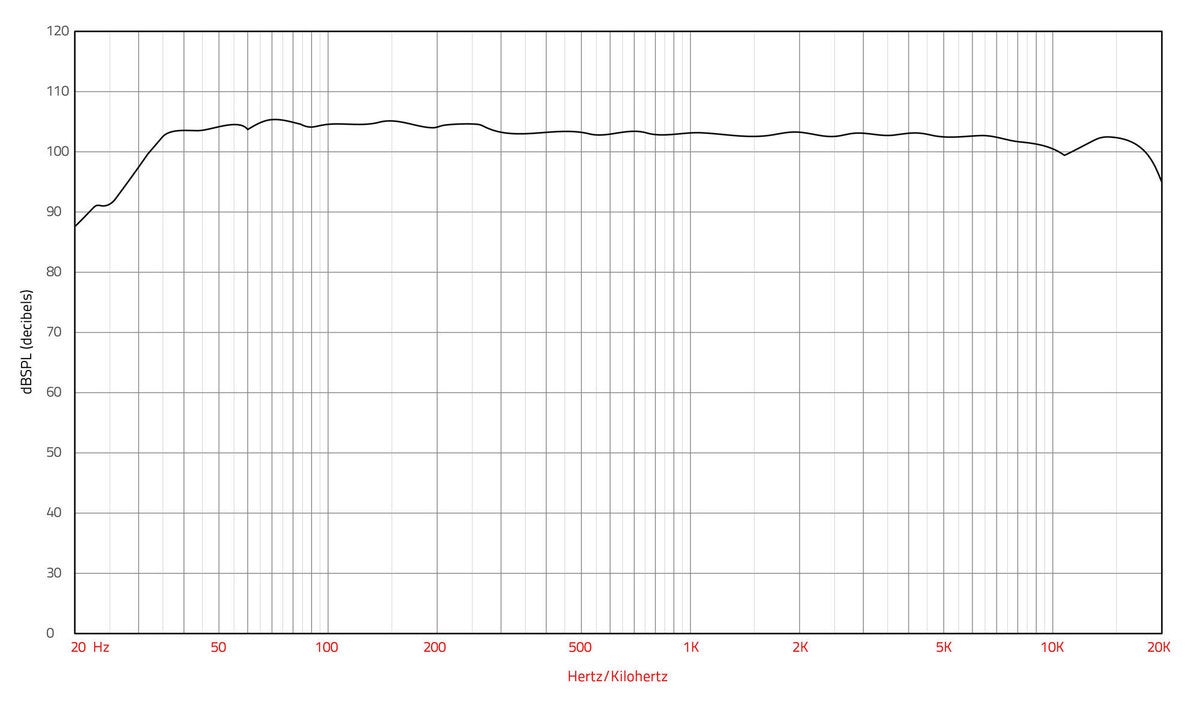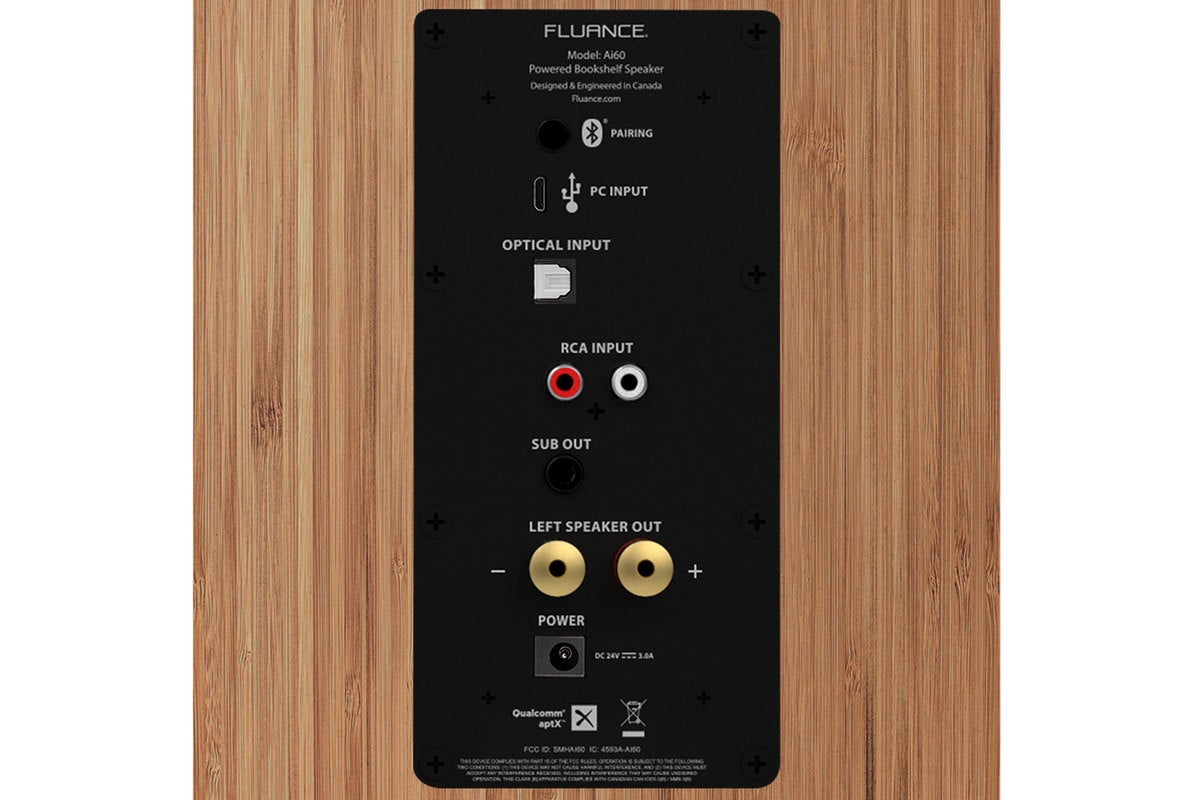This pair of powered Bluetooth speakers has the look, feel, and sound of a high-end product without a high-end price.

Since 1999, Canadian audio company Fluance has built a reputation for high-performance, high-value passive speakers, turntables, and what it calls “music systems”—self-powered Bluetooth speakers. Last year, I reviewed the Fluance Fi20, a small, portable Bluetooth speaker with 360-degree sound radiation and unique styling, but its rich sound was marred by overblown and bloated bass.
When the Fluance Ai60 appeared at my door, I was pleased to see that the package includes a pair of bookshelf speakers with a more conventional 2-way design while retaining the self-contained nature of a so-called music system. It’s not portable like the Fi20, but it sounds orders of magnitude better.
Features
Each Ai60 speaker measures 13.1 x 7.8 x 9.2 inches (HxWxD), and the pair weighs a total of 29.3 pounds. The right speaker houses all the electronics—power supply, power amp, DAC, Bluetooth transceiver, etc.—while the left speaker is entirely passive. You connect the two speakers’ binding posts with the included 8-foot, 18-gauge cable, or you can use another speaker cable if you prefer.
Each speaker is a 2-way design with a 1-inch silk-dome, ferrofluid-cooled tweeter in a shallow waveguide and a 6.5-inch woven glass-fiber composite woofer with butyl rubber surrounds, both in a sealed acoustic-suspension cabinet. (The otherwise similar Ai40 has a 5-inch woofer.) The frequency response is specified from 35Hz to 20kHz (±3 dB) with useful output below 35Hz (see Fig. 1) and a THD (total harmonic distortion) of <0.3%, though no frequency or range is noted.
The Ai60’s frequency response is quite impressive, extending from 35Hz to 20kHz (±3 dB).
The specs refer to the frequency response as “DSP Virtual Sound.” When I asked what that means, the company replied, “We use psychoacoustics to calculate precise harmonics that are related to the fundamental tones of sound. When these harmonics are combined, it creates the effect of lower, deeper frequencies. This is one of the ways we utilize our DSP.” I’m not sure what calculations they’re talking about, since the harmonics are already present in the sound.
The class-D power amp in the right speaker delivers a total of 100 watts RMS continuous power—50W to each speaker. A Cirrus Logic CS8416 DAC does the digital-to-analog conversion, and 18-gauge internal wiring is said to reduce signal degradation within the speaker.
The primary input is Bluetooth 4.2 with support for the aptX codec as well as the A2DP and AVRCP profiles. The physical inputs on the right speaker include TosLink digital optical (which supports PCM only, not Dolby Digital or DTS bitstreams), Micro USB, and a pair of line-level RCA L/R analog connectors. (To use the Ai60 with a turntable, as shown in many of the company’s promo photos, you need a phono preamp, which can be an external device or built into the turntable, along with an RCA-to-RCA cable.) In addition to the binding posts, the right speaker also sports a subwoofer output in case you want to add a sub to the system. The system does not play audio via Wi-Fi.
The connections on the back of the right speaker include (top to bottom) Micro USB for playing audio from a computer, TosLink optical digital (PCM only, not Dolby Digital or DTS), RCA analog, 3.5mm subwoofer output, left-speaker binding-post output, and power receptacle. Notice how close the binding posts are to the power receptacle and sub out. A Bluetooth pairing button is found above the connections.
User interface
A multifunction knob on the front of the right speaker turns the power on and off and adjusts the volume. Pushing the button cycles through the inputs, which are indicated by a multicolored LED next to it. On the back of the right speaker, a button initiates Bluetooth pairing.
The included remote is quite simple. It offers separate buttons for power on/off, mute, input selection, LED brightness, treble up/down, and bass up/down. In addition, there’s a play/pause button that also resets Bluetooth pairing, and a ring around that button provides volume up/down and track-skip forward/back.
One point about the bass and treble controls. They offer six steps of cut or boost, but there is no visual indication of the setting except when you reach the maximum or minimum setting (the LED flashes red twice), and when you reach the 0 setting (the LED flashes the source-indicator color twice). I wish the Ai60 had an app that allowed more accurate visual feedback on these EQ settings. Also, I suspect that the steps are in dB, but this is not specified.
If you like to use voice control, you can pair the Ai60 with an Amazon Alexa device or a Google Home device through a Google Chromecast Audio. The included manual says nothing about this; to learn how, go to Fluance’s YouTube channel and look for the video on setting up the Ai40 (the smaller sibling of the Ai60) with Chromecast, Google Home, and Amazon Alexa.
Performance
I placed the Ai60 speakers on top of my main speakers in the master bedroom, using the main speakers as stands, and I toed in the Ai60s to form an equilateral triangle with my head in the listening position. As I connected the speakers’ binding posts with the included cable, I noticed that the posts on the active speaker are just above the AC power connector and just below the subwoofer output. Since I wasn’t using a sub, I connected the cable from above the posts to avoid routing the cable near the AC power cable.
As usual, I used the Tidal Master library from my iPhone XS as the source material. I started with “Enigma” from Lady Gaga’s new album Chromatica. The overall sound was excellent, with great imaging and super-clean vocals. The bass was deep and powerful—perhaps a bit overemphasized, so I turned down the bass control a couple of clicks from 0.The bass was even more pronounced on “Look Long” from the album of the same name by Indigo Girls. This track starts with loads of bass, which was overwhelming on the Ai60, so I turned down it another click. The bass still sounded a bit indistinct, which, based on other tracks I listened to, was probably in the mix. The vocals, guitars, and drums were all clear and well-defined, with just the barest hint of midrange deficiency.
Staying in the folkish domain, I listened to “Time is on My Side” from All Wood and Stones II by John Batdorf and James Lee Stanley. This is one of my favorite albums lately, featuring tunes from the Rolling Stones’ catalog creatively reimagined by the singer/songwriter duo. Also, this is the only track I played that’s not from Tidal’s Master library—it’s designated as “HiFi”—but the recording quality is superb nonetheless. On the Ai60, the sound was clean and open with excellent vocals and guitars. The deep bass was quite impressive, though perhaps just a touch overblown.
Turning to jazz, I played “Tour of Fourths” from Joined at the Hip by Bob James and Kirk Whalum with full big band, which was recorded in 1996 and remastered in 2019. As I had come to expect, the Ai60 exhibited a super-clear and open sound with an excellent, highly cohesive soundfield and superb imaging. The low bass was quite impressive—not overblown in this case—and the highs were sparkling clean. Each instrument and section was artfully rendered.
For some orchestral music, I listened to the fourth movement (March to the Scaffold) of Berlioz’ Symphonie Fantastique as performed by the Munich Philharmonic under the direction of Sergiu Celibidache. I’m quite familiar with this piece, having played the bass trombone and tuba parts with several different orchestras. It has a wide dynamic range, which the Ai60 rendered with aplomb—the quiet sections were delicate, while the loud passages were full and rich with no congestion. All instruments and sections sounded great—I especially loved the blasting pedal tones from the bass trombone!
Finally, I cued up “A New Home” from the soundtrack album for Star Wars: The Rise of Skywalker. As before, the Ai60 sounded nice and clean with good dynamic range and clearly rendered instruments. The bass was deep and well balanced.
Comparison with KEF LSX
The only similar product I had on hand for comparison was a pair of KEF LSX Bluetooth speakers, which I reviewed in June 2019. Those speakers are about half the size of the Ai60s, they’re ported rather than sealed, and they use a coaxial driver—a 0.75-inch aluminum-dome tweeter at the center of a 4.5-inch magnesium/aluminum alloy-cone woofer. The frequency response is specified from 54, 59, or 69Hz (depending on the Bass Extension setting in the accompanying app) to 28kHz (±3 dB).
Speaking of the app, it provides much more control over the tonality of the LSX than the simple bass/treble controls of the Ai60. In addition, both LSX speakers are wireless with no cable required between them, which means they must both be plugged into an AC power outlet. Another difference is that the LSX can directly stream music from online providers Tidal and Spotify as well as local NAS drives or computers via DLNA and AirPlay 2 over your home’s Wi-Fi network; the Ai60 has no Wi-Fi capabilities. Perhaps most importantly, the LSX system costs about four times as much as the Ai60.
I placed the LSX speakers on top of the Ai60s at the same toe-in angle, and I set the Bass Extension to its Enhanced setting to reach 54Hz, though that’s still half an octave higher than the Ai60’s 35Hz. In addition, I made sure the other controls were tweaked to optimize its performance in that room. Thanks to Tidal’s user interface, I was able to easily switch between them during each track.
Overall, the LSX sounded great but somewhat smaller than the Ai60, and the bass was not as deep or pronounced, which is not surprising. Its sound was generally smoother and richer as well. It had a slightly veiled quality on the Berlioz, and the vocals were a bit more up front on the Indigo Girls tune. I noted a very slightly closed-in lower midrange on the Lady Gaga track, but I’m sure it would only be apparent in a direct A/B comparison such as I performed
Bottom Line
After my experience with the Fi20, I wasn’t expecting to be all that impressed with the Ai60. But after listening to it for a while, my attitude did a 180—I was blown away! The sound is clean and open with sparkling highs, clear midrange, and surprisingly deep, powerful bass. At times, the midrange seemed just a tad deficient, but not always. The soundstage is cohesive, though it does not extend beyond the cabinets, and the imaging is very good.
Overall, the KEF LSX sounds smoother and richer than the Ai60, and it provides much more tonal control from its app. But it does not dig nearly as deep, and it was ever-so-slightly veiled on some tracks. Plus, the Ai60 is twice as big as the LSX, so if you need small speakers to sit near a computer, the KEF is a better fit.
At a penny less than $300, the Fluance Ai60 is a stupendous bargain. If you want something a bit smaller, you could opt for the Ai40 with a 5-inch woofer and 70W amp for $100 less; it’s spec’d to reach down to 40Hz, which is still quite good. But if you have room for these speakers, I doubt you’ll find better sound from Bluetooth speakers for less.
Contact Information:
Scott Wilkinson
Tags:
, Wire, United States, English
Contact Information:
Scott Wilkinson



